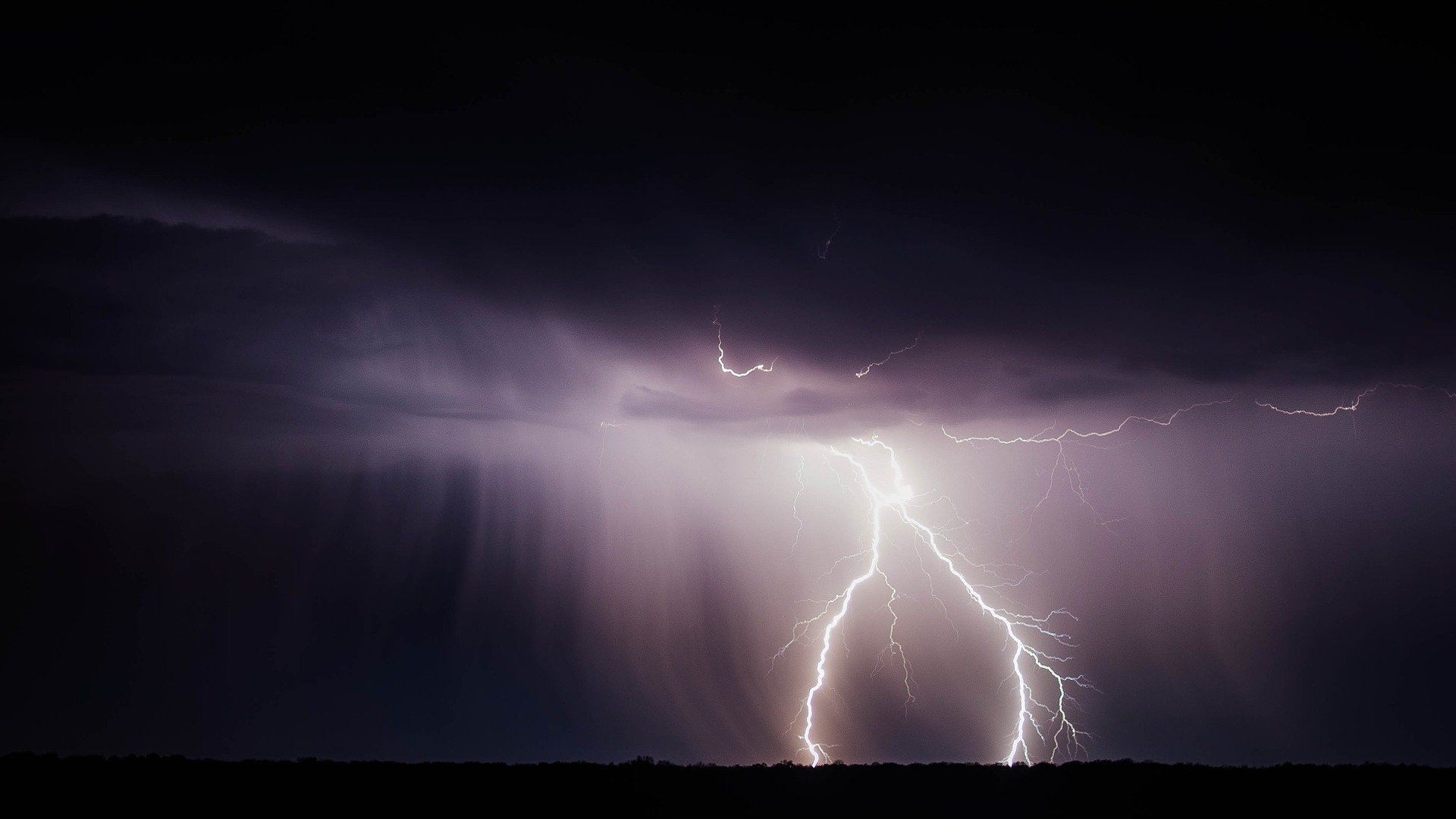https://sputnikglobe.com/20230624/tongas-2022-eruption-sparked-highest-lightning-bolts-on-record-1111440455.html
Tonga's 2022 Eruption Sparked Highest Lightning Bolts on Record
Tonga's 2022 Eruption Sparked Highest Lightning Bolts on Record
Sputnik International
The 2022 South Pacific eruption of the Hunga Tonga-Hunga Ha'apai volcano made history as one of the fiercest on record, sparking the strongest lightning ever witnessed.
2023-06-24T11:31+0000
2023-06-24T11:31+0000
2025-04-07T11:07+0000
beyond politics
south pacific
tonga
nasa
geophysical research letters
us geological survey (usgs)
viral news
https://cdn1.img.sputnikglobe.com/img/07e5/08/06/1083544874_0:96:1921:1176_1920x0_80_0_0_f2fee816d3be76e043a7a61f1e635b18.jpg
A groundbreaking study released this Tuesday in the Geophysical Research Letters journal has revealed an incomparable thunderstorm sparked by electrically-charged ash, supercooled water, and hailstones in a volcanic plume after the 2022 eruption of the Hunga Tonga-Hunga Ha'apai underwater volcano.The storm, described as extraordinary, unleashed a whopping 192,000 lightning flashes, comprising almost half a million electrical pulses, climaxing at 2,615 flashes per minute.NASA equated the explosive power of the erupted Tonga submarine volcano to over 100 Hiroshima bombs detonating at the same time. As the volcano erupted, its magma came into contact with seawater, instantly turning it into vapor. This resulted in a massive mushroom cloud composed of ash, gas, and upwards of 50 million tons of water vapor soaring up the sky.What was unusual was that some lightning bolts reach up to 19 miles (30 kilometers) above sea level. This is considered the highest altitude for lightning flashes ever recorded. This phenomenon is something "we've never seen before," according to Alexa Van Eaton, US Geological Survey's volcanologist and the study's lead author. The volcanic billows can create more intense lightning than ordinary thunderstorms, including those from supercell storms and tropical cyclones, she suggested.The study used data from four sources, including NASA's Geostationary Lightning Mapper, a satellite tool that tracks lightning from space. It discovered that the lightning followed the expansion of the volcanic columns, creating expansive rings. Interestingly, the volcanic clouds from the Hunga Tonga-Hunga Ha'apai eruption lasted for a minimum of 11 hours, which is much longer than the expected 1-2 hours. This means that tracking lightning activity could be an innovative way to estimate the duration of volcanic eruptions. "This discovery presents a new, light-speed method for monitoring volcanoes, aiding the USGS in providing ash hazard advisories to aircraft," Van Eaton concluded.
south pacific
tonga
Sputnik International
feedback@sputniknews.com
+74956456601
MIA „Rossiya Segodnya“
2023
Chimauchem Nwosu
https://cdn1.img.sputnikglobe.com/img/07e7/09/01/1113046371_0:99:1536:1635_100x100_80_0_0_9c5c627283eca931c39fe4852bbb301c.jpg
Chimauchem Nwosu
https://cdn1.img.sputnikglobe.com/img/07e7/09/01/1113046371_0:99:1536:1635_100x100_80_0_0_9c5c627283eca931c39fe4852bbb301c.jpg
News
en_EN
Sputnik International
feedback@sputniknews.com
+74956456601
MIA „Rossiya Segodnya“
Sputnik International
feedback@sputniknews.com
+74956456601
MIA „Rossiya Segodnya“
Chimauchem Nwosu
https://cdn1.img.sputnikglobe.com/img/07e7/09/01/1113046371_0:99:1536:1635_100x100_80_0_0_9c5c627283eca931c39fe4852bbb301c.jpg
tonga submarine volcano eruption, nasa's geostationary lightning mapper, volcanic lightning storm, geophysical research letters journal, high-altitude lightning flashes, us geological survey, volcanologist, alexa van eaton, volcanic eruption duration, volcanic ash hazard, hunga tonga-hunga ha'apai eruption, intense volcanic lightning, volcanic eruption monitoring, ash hazard advisories to aircraft, seawater vapor in volcanic eruptions, electrical pulses in volcanic storms, lightning rings in volcanic columns, impact of volcano eruptions, innovative volcanic activity tracking, explosion power of volcano eruptions, meteorological storms and volcanic eruptions.
tonga submarine volcano eruption, nasa's geostationary lightning mapper, volcanic lightning storm, geophysical research letters journal, high-altitude lightning flashes, us geological survey, volcanologist, alexa van eaton, volcanic eruption duration, volcanic ash hazard, hunga tonga-hunga ha'apai eruption, intense volcanic lightning, volcanic eruption monitoring, ash hazard advisories to aircraft, seawater vapor in volcanic eruptions, electrical pulses in volcanic storms, lightning rings in volcanic columns, impact of volcano eruptions, innovative volcanic activity tracking, explosion power of volcano eruptions, meteorological storms and volcanic eruptions.
Tonga's 2022 Eruption Sparked Highest Lightning Bolts on Record
11:31 GMT 24.06.2023 (Updated: 11:07 GMT 07.04.2025) The 2022 South Pacific eruption of the Hunga Tonga-Hunga Ha'apai underwater volcano made history as one of the fiercest on record.
A groundbreaking study released this Tuesday in the
Geophysical Research Letters journal has revealed an incomparable thunderstorm sparked by electrically-charged ash, supercooled water, and hailstones in a volcanic plume after the 2022 eruption of the Hunga Tonga-Hunga Ha'apai underwater volcano.
The storm, described as extraordinary, unleashed a whopping 192,000 lightning flashes, comprising almost half a million electrical pulses, climaxing at 2,615 flashes per minute.
NASA equated the explosive power of the erupted Tonga submarine volcano to over
100 Hiroshima bombs detonating at the same time. As the volcano erupted, its magma came into contact with seawater, instantly turning it into vapor. This resulted in a massive mushroom cloud composed of ash, gas, and upwards of
50 million tons of water vapor soaring up the sky.
What was unusual was that some lightning bolts reach up to 19 miles (30 kilometers) above sea level. This is considered the highest altitude for lightning flashes ever recorded.
This
phenomenon is something
"we've never seen before," according to Alexa Van Eaton, US Geological Survey's volcanologist and the study's lead author. The volcanic billows can create more intense lightning than ordinary thunderstorms, including those from supercell storms and tropical cyclones, she suggested.
The study used data from four sources, including
NASA's Geostationary Lightning Mapper, a satellite tool that tracks lightning from space. It discovered that the lightning followed the expansion of the volcanic columns, creating expansive rings.
"These lightning rings were unlike anything we've ever seen. There's no comparison in meteorological storms," Van Eaton stressed.
Interestingly, the volcanic clouds from the Hunga Tonga-Hunga Ha'apai eruption lasted for a minimum of 11 hours, which is much longer than the expected 1-2 hours. This means that tracking lightning activity could be an innovative way to estimate the duration of volcanic eruptions. "This discovery presents a new, light-speed method for monitoring volcanoes, aiding the USGS in providing ash hazard advisories to aircraft," Van Eaton concluded.



